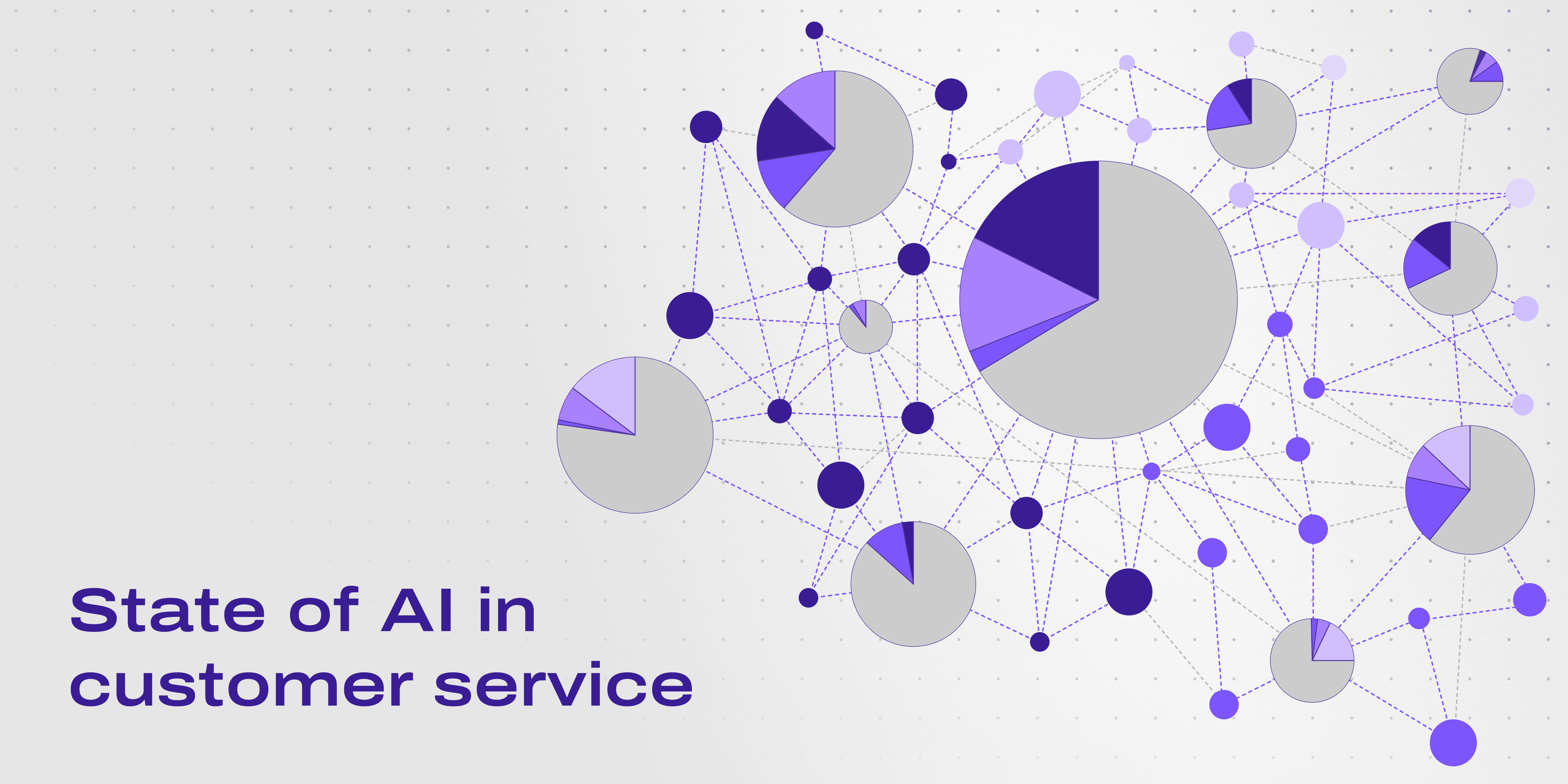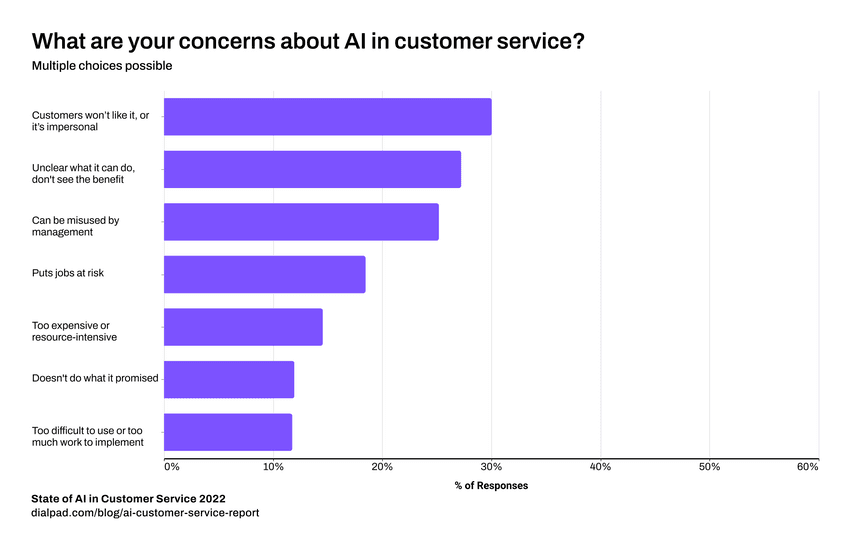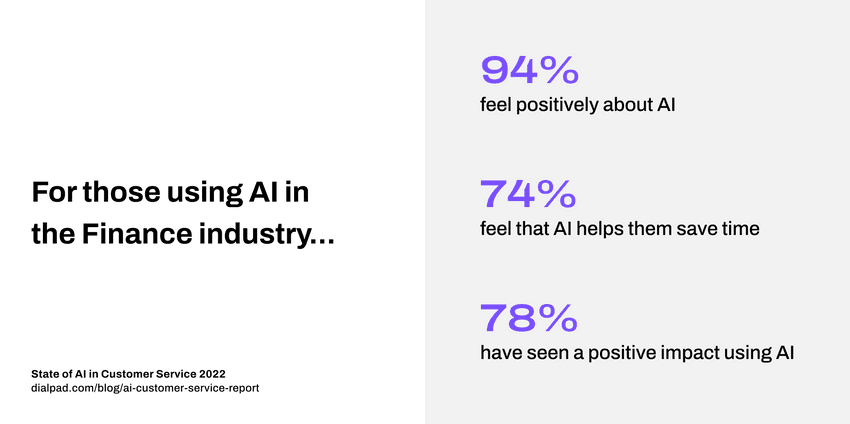The state of AI in customer service 2022: What CS professionals really think

Senior Product Marketing Manager: CCaaS

Tags
Share
If you’re working in customer service or customer experience, when’s the last time artificial intelligence (AI) helped you when you needed it?
It might have been more recent than you realise. Sure, the technology may not be at the point where we have robot butlers doing our shopping, but AI still plays a huge role in customer service.
And from what people working in customer service are saying, we’ve only scratched the surface of what it can do. Or more specifically, we’ve only scratched the surface of how we’re using it.
To better understand how AI is actually being used for customer support right now, why it’s being (or not being) adopted, and more, we surveyed over 1,000 customer service professionals across the US and referenced anonymised data from over 43 million calls on Dialpad’s unified communications platform.
So settle in, ask Siri to silence your calls, tell Alexa to adjust your lights, and let’s take a look at just how much we’re really using AI…
Key findings
There are plenty of key points worth looking at, but to give you an early tl;dr:
Most respondents (77.79%) are feeling optimistic about AI (What are the main concerns that some folks are still worried about?)
66% of respondents say that using AI has a positive impact on business performance (What might be causing the other 34% to see something different?)
Companies using AI for customer service primarily use it to route calls and process customer inquiries
Customer service professionals say AI is helping them save time, answer more calls, and provide better service
Contact centres using AI can handle over twice as many calls. Their ASA, ACD, and abandon rates are better than those that aren’t actively using AI.
One of the main concerns about AI is how customers will respond to it

Let’s get into the details of these responses. Why are respondents feeling this way—and are there misconceptions about AI?
First, let’s look at what might be driving the positive responses—we can think of a few reasons. For starters, businesses that use AI can empower customers with self-service options 24/7/365. Customers can connect with a business, get answers to basic questions, and leave satisfied—without having to talk to someone if they don’t want to. According to Harvard Business Review, 81% of customers try self-service before reaching out to speak to someone.
In fact, AI can still help customers without even needing to interact with them. For example, before a customer speaks to an agent, some AI tools can use intelligent routing to send the call to the best person for the job. AI-powered contact centre platforms (like Dialpad) can even automatically pop up on agents’ screens for conversational guidance (like, “You’re talking too fast.”) and Real-time Assist (RTA) cards that provide answer guidance for specific questions or keywords spoken by customers.
What does this mean for businesses not yet using AI for customer support? Well, based on current research, they’re likely missing out on opportunities to reduce call volumes, provide a better customer experience—and add to their bottom line.
How are customer service professionals feeling about AI?
Despite what we see sometimes on social media, people do seem to like AI.
In fact, over 77 percent of the respondents said they like AI at least a little, and they gave a few reasons for that.
Nearly 60 percent said that using AI has helped save them time, and almost half of the respondents also said that AI makes their jobs easier.
For example: It’s pretty helpful for agents when AI directs inquiries to the agents best suited for those questions. And Dialpad Ai, for instance, also pops up helpful notes on how to answer tricky questions in real-time.

Other reasons for liking AI include the ability to provide support 24/7 (coming in at 42.3 percent), improve customer satisfaction (33 percent), and lower operating costs (26.3 percent). So there is some awareness of the benefits of AI.
But of course, not everyone shares this positive sentiment. 23 percent of respondents didn’t say they like AI. But it’s important to note that out of those, most of them are just feeling neutral. They don’t dislike it—they’re just not too keen on it. (Only 7 percent actively dislike AI.)
At first glance, there may be a few different reasons for this, whether it’s because the companies they’re working for haven’t educated them on what AI can do, or they’re not familiar with many AI-powered customer experience tools, and so on. (It also doesn’t help that most chatbot experiences aren’t great, but that’s another topic for another day.)
So what reasons did the negative respondents give for feeling that way? Turns out our hypothesis may not be too far off:

What is perhaps most noteworthy here is that over a quarter (27 percent) of those who aren’t keen on AI simply don’t know what it can do or the benefits of using it! In that case, it’s a matter of information, education, and experience.
And yes, there are AI tools—any kind of software, really—that overpromise and underdeliver. But from most of the other responses, the “problem with AI” may actually be problems with how it’s being used, how it’s being perceived, and how it’s being marketed or sold.
But even though some respondents were wary about AI, most of them are still optimistic about the direction it’s headed. Over 80 percent of them said they think AI can empower agents to help even more customers, and the data agrees with them, as we’re about to see…
How’s AI used in customer service currently?
The most common use for AI in customer service right now is, drumroll please… routing inquiries, at 47.2 percent!
Right behind that, at 43 percent, we have “processing customer inquiries to determine their needs.” In other words, AI is being mostly used for managing that initial intake:

Coming in at a distant third is “real-time agent assistance” at 28 percent, and just under 20 percent of respondents are using AI for transcribing real-time conversations.
This is interesting because these are some of the most mentioned (and we’d argue most loved) AI-powered features from our conversations with customers—so perhaps these low responses come from a lack of familiarity about what AI can do. It’s possible that these agents aren’t equipped with cloud contact centre platforms that can transcribe calls and provide real-time assists with AI.
Fun fact: Dialpad’s AI has one of the most accurate real-time transcription features out there.
We also asked respondents what they’d like to use AI for, if they had the choice.
The most popular answer matched up with what most respondents are already using AI for, which makes sense—but the second most popular thing they want to use AI for is to automate repetitive tasks (which we can see that less than 25 percent of the respondents are currently using it for):

It’s an interesting disparity. From this finding, it looks like:
Yes, some customer service agents and supervisors are using AI to automate tasks right now, but…
There’s a willingness and even a desire to automate more with AI.
It may be because their businesses aren’t using AI tools that have these automation capabilities. Or, even if they do have the right tools, those features haven’t been “unlocked” and adopted by the wider team—meaning there’s an opportunity to get more out of their existing contact centre or AI software (that they’re paying for).
What’s interesting here is that even the most common use case doesn’t break 50 percent. Why is that?
It’s possible that not everyone is aware that AI can do these things.
For instance, of the 72 percent that aren’t using real-time agent assistance, how many of them are using an AI platform that actually has that feature but they just don’t know about it?
Similarly, why is real-time transcription the least-used AI feature? Its benefits are clear: live transcriptions allow managers to keep an eye on multiple agents’ calls simultaneously, act as records of customer conversations, and are great for training.
Lack of awareness may again be a factor here, but also, not every contact centre platform has real-time transcription. Another reason could be concerns about security and whether AI can be compliant with security and privacy standards.
Finally, the majority of respondents say they’re using AI to support phone calls—those only make up about 31 percent of the responses, followed closely by email. So why, with all that AI can do across different channels, are just a third of businesses using it for phone calls? Sure, there’s bound to be some companies that handle their customer support through email or chat, but overall, it looks like AI is currently underused.

This, too, seems to come down to certain AI tools being more limited and awareness of what AI can be used for in customer service. If a business gets a versatile AI platform but only uses it to help with their phone calls, might it be because they’re simply unaware that they could be using its social media and live chat features too? (And by extension, leaving value on the table?)
Prashanth VK, Head of Market Strategy & Thought Leadership at Zoho CX, shares how their customers use AI on Zoho’s CRM platform (which also integrates with Dialpad):
AI’s real impact
Now that we know how businesses are using AI, the question is: is it really helping them?
Out of the survey respondents who said they use AI, about two-thirds reported that they’ve seen a positive impact on their business as a result. (It could be an improvement in revenue, customer satisfaction, or agent retention—or all of the above.) The finance industry, in particular, had the most positive experience and feelings about AI.

Let’s dig deeper.
Many customer service professionals say that basic questions like “what’s my user number?” or “what’s my account balance?” make up at least 26 to 50 percent of the questions that agents get. For over 20% of the respondents, 50 to 75 percent (or more) of their workload consists of simple requests.

One of the most obvious benefits of AI is precisely that it can take on straightforward requests like these. This is a huge opportunity for AI-powered self-service to lighten the load for agents and give them more time to focus on more complex or pressing issues.
According to respondents, agents are handling, on average, a whopping 41 conversations per day—and we now know that about 10 to 20 (or more) of these are just basic information checking requests that can be answered through AI.
Contact centres that actively use AI vs. those that don’t
What else improves when contact centres use AI? The Average Speed to Answer (ASA).
In fact, over three-quarters of the respondents who like AI believe it can boost their answer time by around 20 percent. And it turns out their guesstimate is pretty close! According to Dialpad data, we found that ASA in contact centres that are actively using Dialpad Ai also improves by about 20%. (The caveat here is that different channels will naturally have different response times—it takes longer to reply to an email than to answer the phone, for instance.)
But that’s not all. The data we gathered from Dialpad calls shows that not only can agents answer calls more quickly, they can also handle twice as many calls when AI has their backs:

For example, when a leading national car rental company started using Dialpad Ai in their contact centre in Q2 2020, they saw a huge spike in the number of calls handled per agent with the help of AI. That's around 50% more calls compared to before:

It doesn’t stop there. For contact centres actively using Dialpad Ai, we also saw improvements in ACD (average call duration) and abandon rates:
Average call duration is 10.06% lower with Dialpad Ai
Abandon rates are 17.36% lower with Dialpad Ai
(The above figures are relative to companies not actively using Dialpad Ai.)
What do these findings mean for businesses?
In short: It looks like we’re barely scratching the surface of what AI can really do.
The majority of respondents working in customer service are feeling positive about AI, especially those who use it on a regular basis.
And while there’s still a ways to go before AI is used more widely, it looks like that at least right now, most of the setbacks aren’t due to any problems with AI’s actual capabilities, but rather a lack of knowledge around them.
Our recommendations for businesses and organisations using AI-powered tools? Make a plan for how you want your staff to use AI. From helping employees understand what AI can do exactly in their day-to-day work, to choosing the right platforms to manage customer communications across all your channels, there are different ways to get more out of the technology you’re paying for every month and really maximise that ROI.
And of course: businesses need to do their research about the AI they use.
Decision makers should know what AI needs to do for them as leaders and managers, what their customer experience agents actually need, and what the onboarding and implementation process looks like. IT teams and contact centre managers should also make sure they have regular training sessions to make sure agents are up to date on what the software they’re using can do.
Implementing AI in customer service can be a significant investment of both dollars, time, and other resources. Doing this groundwork makes it much more likely that they’ll be able to reap the benefits and maximise ROI.
Of course, the other key to this is to use a robust and intuitively designed contact centre solution with built-in AI. Dialpad Ai Contact Centre, for example, is easy to set up (in minutes) and very customisable. And of course, it has its own proprietary AI that’s built by our in-house team and integrated directly into the platform—with no add-ons or third party whitelabelled solutions.
Humanity once dreamed of a future where machines would help us with everyday tasks. And while the world today certainly looks different than what science fiction dreamed up, that future is still here, now (at least in our contact centres).
Methodology
The data is based on a survey in February 2022 of 1,058 Customer Service professionals based in the U.S. and across a variety of industries. We also analysed anonymised Dialpad data of over 43 million calls to learn more about how the usage of AI affects different contact centre KPIs.
Take Dialpad for a spin
Book a demo of Dialpad Ai Contact Centre, or take a self-guided interactive tour of the app on your own!








